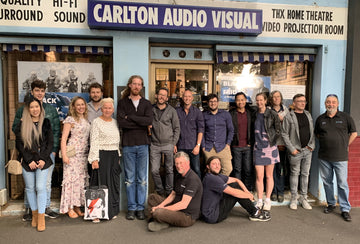If you are in the market for a high end video projection device this is something interesting that I've pulled from web sources being Projector Central and Texas Instruments.
Texas Instruments commissioned a lab test to compare the relative stability and longevity of the DLP and LCD technologies. The test commenced in May, 2002. Two DLP projectors and five LCD projectors were run 24 hours a day, 7 days a week for five months, with breaks only to change lamps as needed. During this time each projector was periodically measured for lumen output, contrast, uniformity, and color chromaticity for white, red, green, and blue.
Though sponsored by TI, the test itself was conducted at the Munsell Color Science Laboratory (MCSL) ( www.cis.rit.edu/research/mcsl/), Rochester Institute of Technology. The technical measurements were taken by MCSL personnel. The selection of the models to be included in the test was done by TI. The interpretation of the results and the publishing of the conclusions was done by TI.
Texas Instruments released the results of the test to the public in March, 2003. In summary, the test results indicated that the two DLP projectors used in the evaluation delivered stable contrast and color balance that remained relatively unchanged for over 4,000 hours of continuous operation. Meanwhile, the five LCD projector test units tended to shift color balance and lose contrast over time. Based on the judgment of TI personnel overseeing the test, the image quality of the LCD projectors eroded fairly rapidly, eventually degrading to the point of becoming subjectively "unacceptable." TI defined this unacceptable condition as the point at which TI believed the picture quality was sufficiently degraded that an average user would not be satisfied with it. The first LCD projector was judged to reach this unacceptable condition in just 1368 hours of operation. The remaining four units were said to have degraded to an unacceptable state in 2160, 2352, 3456, and 3456 hours respectively.
Texas Instruments claims that the results of this test are evidence that DLP technology is superior to LCD when it comes to "picture reliability" over the projector's anticipated lifetime. Picture reliability is defined by TI as the ability to maintain consistent image quality throughout the life of the projector.
Description of the Lab Test:
The test was conducted at the facilities of the Munsell Color Science Laboratory in Rochester, NY. It was carried out in a dedicated 10 x 18 foot room. Eight projectors were operated essentially 24 hours per day, 7 days per week. These included the two DLP projectors and five LCD projectors already noted, plus an LCOS-based projector. The technical performance data pertaining to the LCOS machine was not included in the final report issued by TI since a sample of one is not sufficient to support any conclusions about the technology.
The two DLP and five LCD machines were portable-class machines. Six of the seven units (both DLPs and all but one of the LCDs) were XGA resolution. The fifth LCD unit was 16:9 format of unspecified resolution. The five LCD projectors consisted of three with 0.9" panels and two with 0.7" panels. The DLP units represented one each of 0.9" and 0.7" chips. Both DLP projectors were rated at 2000 ANSI lumens. The five LCDs had brightness ratings of 800, 1000, 1100, 2000, and 2000 ANSI lumens.
The eight units in the test were placed in fairly close proximity, from a minimum of 4 to 5 inches, to as much as a foot or more apart. They were placed on three shelves one above another, with several units on each shelf. They were arranged in a manner to prevent the hot exhaust of one unit feeding the intake vent of another. At the end of each shelf a fan was installed to blow air across all units on that shelf. The objective of these fans was to distribute cool air from the air conditioning vents as evenly as possible over all units.
The room was cooled by a central air conditioning unit operated by a wall-mounted thermostat located about 10 to 12 feet from the projectors. Average ambient temperature in the room during the test was 25 degrees C, or 77 degrees F. The actual temperature variance range around the average any given point in time was about ten degrees F, from just under 75 degrees to the mid-80's. Temperatures rose and fell in this range with the cycling of the air conditioning system.
The projectors were run round the clock seven days a week, with downtime for the changing of lamps and filter cleaning/replacement as necessary. They were all fed the same computer data signal with rotating graphic images to prevent burn-in. Technical performance measurements were taken at days 0, 1, 2, and 4; weeks 1, 2, and 4; and months 2, 3, 4, and 5.
Results as reported by Texas Instruments
At the end of about 4700 hours of operation, TI summarized the results as follows:
1. Full On/Off, and ANSI contrast degraded over time on all five LCD units, but remained relatively constant on the two DLPs.
2. The optical degradation seen in the LCDs washed the picture out and raised the dark levels.
3. Color chromaticity remained stable on the DLPs, but significant changes were seen in the LCDs. There was a visible yellowing of the image on all the units, and some later developed a "blue blemish" as well.
4. The pattern of degradation was the same on all five LCD products tested. The degradation occurred first in the blue channel. TI's theory is that the organic compounds in the polarizer and LCD panel were breaking down under exposure to high frequency blue and UV light. Eventually there are signs of breakdown in the red and green channels as well.
5. The first of the LCD projectors to fail was judged by TI personnel to have reached an unacceptable condition in 1368 hours of operation. Subsequent failure of the other four units occurred at 2160, 2352, 3456, and 3456 hours.
Based on these test results, TI suggests that a fundamental flaw exists in LCD technology that causes the picture quality it delivers to deteriorate well before the end of life of the projector itself might be expected. Because DLP technology is allegedly immune to degradation, it is purported to offer a lower cost-of-ownership since DLP projectors do not need to be replaced as often as LCD-based products.
Texas Instruments own web site link to this matter
Opinions





